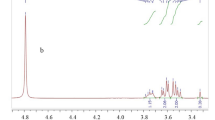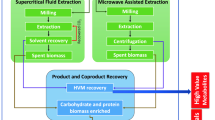Abstract
Biodiesel industrial effluent rich in crude glycerol (CG) was processed to produce value-added product. Under continuous culture system, Bacillus amyloliquefaciens strain CD16 immobilized within its biofilm, produced 3.2 L H2/day/L feed, over a period of 60 days at a hydraulic retention time of 2 days. The effective H2 yield by B. amyloliquefaciens strain CD16 was 165 L/L CG. This H2 yield was 1.18-fold higher than that observed with non-biofilm forming Bacillus thuringiensis strain EGU45. Bioprocessing of the effluent released after this stage, by recycling it up to 25% did not have any adverse effect on H2 production by strain EGU45; however, a 25% reduction in yield was recorded with strain CD16. Biofilm forming H2 producers thus proved effective as self-immobilizing system leading to enhanced process efficiency.




Similar content being viewed by others
References
Spier, F., Buffon, J. G., & Burkert, C. A. (2015). Bioconversion of raw glycerol generated from the synthesis of biodiesel by different oleaginous yeasts: lipid content and fatty acid profile of biomass. Indian Journal of Microbiology, 55, 415–422. https://doi.org/10.1007/s12088-015-0533-9.
Ray, S., & Kalia, V. C. (2016). Co-metabolism of substrates by Bacillus thuringiensis regulates polyhydroxyalkanoate co-polymer composition. Bioresource Technology, 224, 743–747. https://doi.org/10.1016/j.biortech.2016.11.089.
Begum, I. F., Mohankumar, R., Jeevan, M., & Ramani, K. (2016). GC–MS analysis of bioactive molecules derived from Paracoccus pantotrophus FMR19 and the antimicrobial activity against bacterial pathogens and MDROs. Indian Journal of Microbiology, 56, 426–432. https://doi.org/10.1007/s12088-016-0609-1.
Hernández-Saldaña, O. F., Valencia-Posadas, M., de la Fuente-Salcido, N. M., Bideshi, D. K., & Barboza-Corona, J. E. (2016). Bacteriocinogenic bacteria isolated from raw goat milk and goat cheese produced in the center of México. Indian Journal of Microbiology, 56, 301–308. https://doi.org/10.1007/s12088-016-0587-3.
Jeyanthi, V., & Velusamy, P. (2016). Anti-methicillin resistant Staphylococcus aureus compound isolation from halophilic Bacillus amyloliquefaciens MHB1 and determination of its mode of action using electron microscope and flow cytometry analysis. Indian Journal of Microbiology, 56, 148–157. https://doi.org/10.1007/s12088-016-0566-8.
Varsha, K. K., Nishant, G., Sneha, S. M., Shilpa, G., Devendra, L., Priya, S., & Nampoothiri, K. M. (2016). Antifungal, anticancer and aminopeptidase inhibitory potential of a phenazine compound produced by Lactococcus BSN307. Indian Journal of Microbiology, 56, 411–416. https://doi.org/10.1007/s12088-016-097-1.
Wadhwani, S. A., Shedbalkar, U. U., Singh, R., Vashisth, P., Pruthi, V., & Chopade, B. A. (2016). Kinetics of synthesis of gold nanoparticles by Acinetobacter sp. SW30 isolated from environment. Indian Journal of Microbiology, 56, 439–444. https://doi.org/10.1007/s12088-016-0598-0.
Sanchart, C., Rattanaporn, O., Haltrich, D., Phukpattaranont, P., & Maneerat, S. (2017). Lactobacillus futsaii CS3, a new GABA-producing strain isolated from Thai fermented shrimp (Kung–Som). Indian Journal of Microbiology, 57, 211–217. https://doi.org/10.1007/s12088-016-0632-2.
Ibrahim, M. H. A., & Steinbüchel, A. (2010). Zobellella denitrificans strain MW1, a newly isolated bacterium suitable for poly (3-hydroxybutyrate) production from glycerol. Journal of Applied Microbiology, 108, 214–225. https://doi.org/10.1111/j.1365-2672.2009.04413.x.
Kumar, P., Mehariya, S., Ray, S., Mishra, A., & Kalia, V. C. (2015). Biodiesel industry waste: a potential source of bioenergy and biopolymers. Indian Journal of Microbiology, 55, 1–7. https://doi.org/10.1007/s12088-014-0509-1.
Kumar, P., Ray, S., Patel, S. K. S., Lee, J. K., & Kalia, V. C. (2015). Bioconversion of crude glycerol to polyhydroxyalkanoate by Bacillus thuringiensis under non-limiting nitrogen conditions. International Journal of Biological Macromolecules, 31, 9–16. https://doi.org/10.1016/j.ijbiomac.2015.03.046.
Kumar, P., Sharma, R., Ray, S., Mehariya, S., Patel, S. K. S., Lee, J. K., & Kalia, V. C. (2015). Dark fermentative bioconversion of glycerol to hydrogen by Bacillus thuringiensis. Bioresource Technology, 182, 383–388. https://doi.org/10.1016/j.biortech.2015.01.138.
Kalia, V. C., Prakash, J., & Koul, S. (2016). Biorefinery for glycerol rich biodiesel industry waste. Indian Journal of Microbiology, 56, 113–125. https://doi.org/10.1007/s12088-016-0583-7.
Cofré, O., Ramírez, M., Gómez, J. M., & Cantero, D. (2016). Pilot scale fed-batch fermentation in a closed loop mixed reactor for the biotransformation of crude glycerol into ethanol and hydrogen by Escherichia coli MG1655. Biomass and Bioenergy, 91, 37–47. https://doi.org/10.1016/j.biombioe.2016.04.015.
Rodrigues, C. V., Santana, K. O., Nespeca, M. G., de Oliveira, J. E., & Maintinguer, S. I. (2016). Crude glycerol by transesterification process from used cooking oils: characterization and potentialities on hydrogen bioproduction. International Journal of Hydrogen Energy, 41, 14641–14651. https://doi.org/10.1016/j.ijhydene.2016.06.209.
Pachapur, V. L., Das, R. K., Brar, S. K., Le Bihan, Y., & Buelna, G. (2017). Valorization of crude glycerol and eggshell biowaste as media components for hydrogen production: a scale-up study using co-culture system. Bioresource Technology, 225, 386–394. https://doi.org/10.1016/j.biortech.2016.11.114.
Kumar, P., Patel, S. K. S., Lee, J. K., & Kalia, V. C. (2013). Extending the limits of Bacillus for novel biotechnological applications. Biotechnology Advances, 31, 1543–1561. https://doi.org/10.1016/j.biotechadv.2013.08.007.
Lopes, H. J. S., Ramos, L. R. & Silva, E. L. (2017). Co-fermentation of cheese whey and crude glycerol in EGSB reactor as a strategy to enhance continuous hydrogen and propionic acid production. Applied Biochemistry and Biotechnology 1–17. https://doi.org/10.1007/s12010-017-2459-7.
Jitrwung, R., & Yargeau, V. (2015). Biohydrogen and bioethanol production from biodiesel-based glycerol by Enterobacter aerogenes in a continuous stir tank reactor. International Journal of Molecular Sciences, 11, 10650–10664. https://doi.org/10.3390/ijms160510650.
Fernandes, B. S., Saavedra, N. K., Maintinguer, S. I., Sette, L. D., Oliveira, V. M. D., Varesche, M. B. A., et al. (2013). The effect of biomass immobilization support material and bed porosity on hydrogen production in an upflow anaerobic packed-bed bioreactor. Applied Biochemistry and Biotechnology, 170, 1348–1366. https://doi.org/10.1007/s12010-013-0262-7.
Kumar, G., Mudhoo, A., Sivagurunathan, P., Nagarajan, D., Ghimire, A., Lay, C. H., Lin, C. Y., Lee, D. J., & Chang, J. S. (2016). Recent insights into the cell immobilization technology applied for dark fermentative hydrogen production. Bioresource Technology, 219, 725–737. https://doi.org/10.1016/j.biortech.2016.08.065.
Lutpi, N. A., Md Jahim, J., Mumtaz, T., Harun, S., & Abdul, P. M. (2016). Batch and continuous thermophilic hydrogen fermentation of sucrose using anaerobic sludge from palm oil mill effluent via immobilization technique. Process Biochemistry, 51, 297–307. https://doi.org/10.1016/j.procbio.2015.11.031.
Gokfiliz, P., & Karapinar, I. (2016). The effect of support particle type on thermophilic hydrogen production by immobilized batch dark fermentation. International Journal of Hydrogen Energy, 42, 2553–2561. https://doi.org/10.1016/j.ijhydene.2016.03.041.
Kirli, B., & Kapdan, I. K. (2016). Selection of microorganism immobilization particle for dark fermentative biohydrogen production by repeated batch operation. Renewable Energy, 87, 697–702. https://doi.org/10.1016/j.renene.2015.11.003.
Kao, P. M., Hsu, B. M., Tao, C. W., Hsu, T. K., & Chang, C. M. (2016). Control strategies for biohydrogen production by immobilized co-culture of Clostridium butyricum and Rhodopseudomonas palustris. International Journal of Green Energy, 13, 977–982. https://doi.org/10.1080/15435075.2015.1088444.
Sharma, A., & Lal, R. (2017). Survey of (Meta) genomic approaches for understanding microbial community dynamics. Indian Journal of Microbiology, 57, 23–38. https://doi.org/10.1007/s12088-016-0629-x.
Ahiwale, S. S., Bankar, A. V., Tagunde, S., & Kapadnis, B. P. (2017). A bacteriophage mediated gold nanoparticle synthesis and their anti-biofilm activity. Indian Journal of Microbiology, 57, 188–194. https://doi.org/10.1007/s12088-017-0640-x.
Azman, C. A-S., Othman, I., Fang, C-M., Chan, K-G., Goh, B-H., & Lee, L-H. (2017). Antibacterial, anticancer and neuroprotective activities of rare actinobacteria from mangrove forest soils. Indian Journal of Microbiology, 57, 177–187. https://doi.org/10.1007/s12088-016-0627-z.
Das, K., Rajawat, M. V. S., Saxena, A. K., & Prasanna, R. (2017). Development of mesorhizobium ciceri-based biofilms and analyses of their antifungal and plant growth promoting activity in chickpea challenged by fusarium wilt. Indian Journal of Microbiology, 57, 48–59. https://doi.org/10.1007/s12088-016-0610-8.
de Paula Valim, F., Aguiar-Oliveira, E., Kamimura, E. S., Alves, V. D., & Maldonado, R. R. (2016). Production of star fruit alcoholic fermented beverage. Indian Journal of Microbiology, 56, 476–481. https://doi.org/10.1007/s12088-016-0601-9.
Ercan, D., & Demirci, A. (2015). Current and future trends for biofilm reactors for fermentation processes. Critical Reviews in Biotechnology, 35, 1–14. https://doi.org/10.3109/07388551.2013.793170.
Patel, S. K. S., Kumar, P., Mehariya, S., Purohit, H. J., Lee, J. K., & Kalia, V. C. (2014). Enhancement in hydrogen production by co-cultures of Bacillus and Enterobacter. International Journal of Hydrogen Energy, 39, 14663–14668. https://doi.org/10.1016/j.ijhydene.2014.07.084.
Kalia, V. C., Prakash, J., Koul, S., & Ray, S. (2016). Simple and rapid method for detecting biofilm forming bacteria. Indian Journal of Microbiology, 57, 109–111. https://doi.org/10.1007/s12088-016-0616-2.
Chattaraj, S., Purohit, H. J., Sharma, A., Jadeja, N. B., & Madamwar, D. (2016). Treatment of common effluent treatment plant wastewater in a sequential anoxic–oxic batch reactor by developed bacterial consortium vn11. Applied Biochemistry and Biotechnology, 179, 514–529. https://doi.org/10.1007/s12010-016-2010-2.
Chandran, P., & Das, N. (2011). Degradation of diesel oil by immobilized Candida tropicalis and biofilm formed on gravels. Biodegradation, 22, 1181–1189. https://doi.org/10.1007/s10532-011-9473-1.
Al-Mailem, D. M., Kansour, M. K., & Radwan, S. S. (2014). Bioremediation of hydrocarbons contaminating sewage effluent using man-made biofilms: effects of some variables. Applied Biochemistry and Biotechnology, 174, 1736–1751. https://doi.org/10.1007/s12010-014-1067-z.
Gulhane, M., Pandit, P., Khardenavis, A., Singh, D., & Purohit, H. J. (2017). Study of microbial community plasticity for anaerobic digestion of vegetable waste in anaerobic baffled reactor. Renewable Energy, 101, 59–66. https://doi.org/10.1016/j.renene.2016.08.021.
Akinbomi, J., Wikandari, R., & Taherzadeh, M. J. (2015). Enhanced fermentative hydrogen and methane production from an inhibitory fruit-flavored medium with membrane-encapsulated cells. Membranes, 5, 616–631. https://doi.org/10.3390/membranes5040616.
Andreani, C. L., Torres, D. G., Schultz, L., de Carvalho, K. Q., & Gomes, S. D. (2015). Hydrogen production from cassava processing wastewater in an anaerobic fixed bed reactor with bamboo as a support material. Eng. Agríc, 35, 578–587. https://doi.org/10.1590/1809–4430-Eng.Agric.v35n3p578–587/2015.
Paliwal, V., Puranik, S., & Purohit, H. J. (2012). Integrated perspective for effective bioremediation. Applied Biochemistry and Biotechnology, 166, 903–924. https://doi.org/10.1007/s12010-011-9479-5.
Bravo, I. M., Lovato, G., Rodrigues, J. A. D., Ratusznei, S. M., & Zaiat, M. (2015). Biohydrogen production in an AnSBBR treating glycerin-based wastewater: Effects of organic loading, influent concentration, and cycle time. Applied Biochemistry and Biotechnology, 175, 1892–1914. https://doi.org/10.1007/s12010-014-1421-1.
Markov, S. A., Averitt, J., & Waldron, B. (2011). Bioreactor for glycerol conversion into H2 by bacterium Enterobacter aerogenes. International Journal of Hydrogen Energy, 36, 262–266. https://doi.org/10.1016/j.ijhydene.2010.09.090.
Lo, Y. C., Chen, X. J., Huang, C. Y., Yuan, Y. J., & Chang, J. S. (2013). Dark fermentative hydrogen production with crude glycerol from biodiesel industry using indigenous hydrogen-producing bacteria. International Journal of Hydrogen Energy, 38, 15815–15822. https://doi.org/10.1016/j.ijhydene.2013.05.083.
Acknowledgements
We are thankful to the Director of CSIR-Institute of Genomics and Integrative Biology (CSIR-IGIB), and CSIR-HRD (ES Scheme No. 21(1022)/16/EMR-II) for providing the necessary funds, facilities, and moral support. Authors are also thankful to Academy of Scientific & Innovative Research (AcSIR), New Delhi, and JP is also thankful to University Grants Commission (UGC).
Author information
Authors and Affiliations
Corresponding author
Ethics declarations
Conflict of Interest
The authors declare that they have no conflict of interest.
Electronic supplementary material
Fig. S1
(DOCX 58 kb)
Rights and permissions
About this article
Cite this article
Prakash, J., Gupta, R.K., XX, P. et al. Bioprocessing of Biodiesel Industry Effluent by Immobilized Bacteria to Produce Value-Added Products. Appl Biochem Biotechnol 185, 179–190 (2018). https://doi.org/10.1007/s12010-017-2637-7
Received:
Accepted:
Published:
Issue Date:
DOI: https://doi.org/10.1007/s12010-017-2637-7




